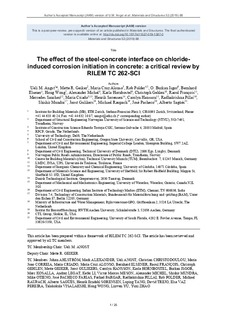The effect of the steel-concrete interface on chlorideinduced corrosion initiation in concrete: a critical review by RILEM TC 262-SCI
| dc.contributor.author | Angst, Ueli M | |
| dc.contributor.author | Geiker, Mette Rica | |
| dc.contributor.author | Alonso, Maria Cruz | |
| dc.contributor.author | Polder, Rob | |
| dc.contributor.author | Isgor, Burkan | |
| dc.contributor.author | Elsener, Bernhard | |
| dc.contributor.author | Wong, Hong | |
| dc.contributor.author | Michel, Alexander | |
| dc.contributor.author | Hornbostel, Karla | |
| dc.contributor.author | Gehlen, Christoph | |
| dc.contributor.author | Francois, Raoul | |
| dc.contributor.author | Sanchez, Mercedes | |
| dc.contributor.author | Criado, Maria | |
| dc.contributor.author | Sørensen, Henrik | |
| dc.contributor.author | Hansson, Carolyn M | |
| dc.contributor.author | Pillai, Radhakrishna | |
| dc.contributor.author | Mundra, Shishir | |
| dc.contributor.author | Gulikers, Joost | |
| dc.contributor.author | Raupach, Michael | |
| dc.contributor.author | Pacheco, José F. | |
| dc.contributor.author | Sagues, Alberto | |
| dc.date.accessioned | 2019-10-24T07:05:16Z | |
| dc.date.available | 2019-10-24T07:05:16Z | |
| dc.date.created | 2019-10-18T14:49:22Z | |
| dc.date.issued | 2019 | |
| dc.identifier.citation | Materials and Structures. 2019, 52 (88) | nb_NO |
| dc.identifier.issn | 1359-5997 | |
| dc.identifier.uri | http://hdl.handle.net/11250/2624033 | |
| dc.description.abstract | The steel–concrete interface (SCI) is known to influence corrosion of steel in concrete. However, due to the numerous factors affecting the SCI—including steel properties, concrete properties, execution, and exposure conditions—it remains unclear which factors have the most dominant impact on the susceptibility of reinforced concrete to corrosion. In this literature review, prepared by members of RILEM technical committee 262-SCI, an attempt is made to elucidate the effect of numerous SCI characteristics on chloride-induced corrosion initiation of steel in concrete. We use a method to quantify and normalize the effect of individual SCI characteristics based on different literature results, which allows comparing them in a comprehensive context. It is found that the different SCI characteristics have received highly unbalanced research attention. Parameters such as w/b ratio and cement type have been studied most extensively. Interestingly, however, literature consistently indicates that those parameters have merely a moderate effect on the corrosion susceptibility of steel in concrete. Considerably more pronounced effects were identified for (1) steel properties, including metallurgy, presence of mill scale or rust layers, and surface roughness, and (2) the moisture state. Unfortunately, however, these aspects have received comparatively little research attention. Due to their apparently strong influence, future corrosion studies as well as developments towards predicting corrosion initiation in concrete would benefit from considering those aspects. Particularly the working mechanisms related to the moisture conditions in microscopic and macroscopic voids at the SCI is complex and presents major opportunities for further research in corrosion of steel in concrete. | nb_NO |
| dc.language.iso | eng | nb_NO |
| dc.publisher | Springer | nb_NO |
| dc.title | The effect of the steel-concrete interface on chlorideinduced corrosion initiation in concrete: a critical review by RILEM TC 262-SCI | nb_NO |
| dc.type | Journal article | nb_NO |
| dc.type | Peer reviewed | nb_NO |
| dc.description.version | acceptedVersion | nb_NO |
| dc.source.volume | 52 | nb_NO |
| dc.source.journal | Materials and Structures | nb_NO |
| dc.source.issue | 88 | nb_NO |
| dc.identifier.doi | 10.1617/s11527-019-1387-0 | |
| dc.identifier.cristin | 1738507 | |
| dc.description.localcode | This is a post-peer-review, pre-copyedit version of an article published in Materials and Structures. Locked until 12 August 2020 due to copyright restrictions. The final authenticated version is available online at: https://doi.org/10.1617/s11527-019-1387-0. | nb_NO |
| cristin.unitcode | 194,64,45,0 | |
| cristin.unitname | Institutt for konstruksjonsteknikk | |
| cristin.ispublished | true | |
| cristin.fulltext | postprint | |
| cristin.qualitycode | 1 |
